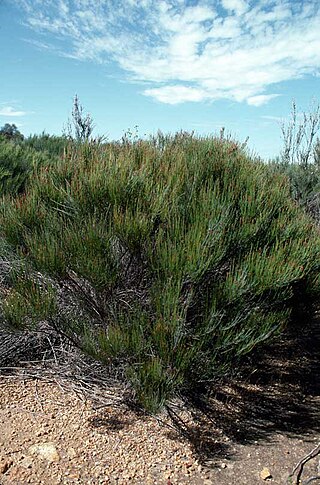
Allocasuarina campestris is a species of flowering plant in the family Casuarinaceae and is endemic to the south-west of Western Australia. It is a dense, monoecious or dioecious shrub that has more or less erect branchlets, the leaves reduced to scales in whorls of seven to nine, the mature fruiting cones 19–42 mm (0.75–1.65 in) long containing winged seeds (samaras) 4.7–10 mm (0.19–0.39 in) long.

Allocasuarina defungens, commonly known as dwarf heath casuarina, is a species of flowering plant in the family Casuarinaceae and is endemic to a restricted area of New South Wales. It is a straggly, dioecious or monoecious shrub that has branchlets up to 120 mm (4.7 in) long, the leaves reduced to scales in whorls of five to seven, the fruiting cones 8–11 mm (0.31–0.43 in) long containing winged seeds (samaras) about 3 mm (0.12 in) long.

Grevillea asteriscosa, commonly known as star-leaf grevillea, is a species of flowering plant in the family Proteaceae and is endemic to the south-west of Western Australia. It is a shrub with widely-spreading branches, star-shaped leaves with sharply-pointed lobes, and bright red flowers.

Isopogon alcicornis, commonly known as the elkhorn coneflower, is a plant in the family Proteaceae and is endemic to part of the South Coast Western Australia. It is a low shrub with pinnately-lobed leaves and oval heads of hairy, white or pink flowers.
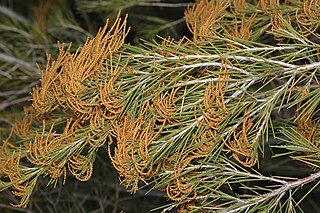
Allocasuarina acuaria is a species of flowering plant in the family Casuarinaceae and is endemic to the southwest of Western Australia. It is a dioecious shrub that has erect branchlets, the leaves reduced to scales in whorls of four on the ends of the branchlets, the fruiting cones 15–19 mm (0.59–0.75 in) long containing winged seeds (samaras) about 6 mm (0.24 in) long.

Allocasuarina acutivalvis is a species of flowering plant in the family Casuarinaceae and is endemic to the southwest of Western Australia. It is a dioecious shrub to small tree that has erect branchlets, the leaves reduced to scales in whorls of 10 to 14, the fruiting cones 15–35 mm (0.59–1.38 in) long containing winged seeds (samaras) 6–12 mm (0.24–0.47 in) long.
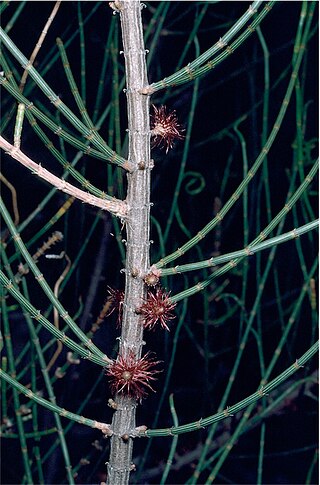
Allocasuarina corniculata is a species of flowering plant in the family Casuarinaceae and is endemic to the south-west of Western Australia. It is an erect to spreading, dioecious shrub that has more or less erect branchlets, the leaves reduced to scales in whorls of six to eleven, the mature fruiting cones 8–15 mm (0.31–0.59 in) long containing winged seeds (samaras) 3–4 mm (0.12–0.16 in) long.

Allocasuarina dielsiana, commonly known as northern sheoak, is a species of flowering plant in the family Casuarinaceae and is endemic to the south-west of Western Australia. It is a dioecious tree that has more or less erect branchlets, the leaves reduced to scales in whorls of six to eight, and the mature fruiting cones 14–30 mm (0.55–1.18 in) long containing winged seeds (samaras) 8–10 mm (0.31–0.39 in) long.

Allocasuarina eriochlamys is a species of flowering plant in the family Casuarinaceae and is endemic to inland areas of Western Australia. It is a dense, erect, monoecious or dioecious shrub that has more or less erect branchlets, its leaves reduced to scales in whorls of eight to ten, the mature fruiting cones 20–45 mm (0.79–1.77 in) long containing winged seeds (samaras) 5.0–10.5 mm (0.20–0.41 in) long.

Allocasuarina fibrosa, commonly known as woolly sheoak, is a species of flowering plant in the family Casuarinaceae and is endemic to the south-west of Western Australia. It is a dioecious shrub that has branchlets 20–50 mm (0.79–1.97 in) long, the leaves reduced to scales in whorls of four, and the mature fruiting cones 11–25 mm (0.43–0.98 in) long containing winged seeds (samaras) 6–7 mm (0.24–0.28 in) long.
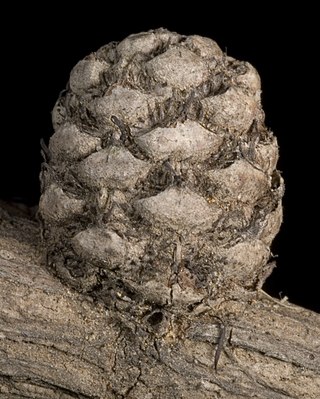
Allocasuarina ramosissima is a species of flowering plant in the family Casuarinaceae and is endemic to the south-west of Western Australia. It is a dioecious shrub with its leaves reduced to overlapping scales in whorls of five, the mature fruiting cones sessile and 9–13 mm (0.35–0.51 in) long, containing winged seeds 4.5–5.0 mm (0.18–0.20 in) long.
Grevillea eremophila is a species of flowering plant in the family Proteaceae and is endemic to the south-west of Western Australia. It is an erect shrub with leathery, linear to narrowly egg-shaped leaves with the narrower end towards the base, and creamy-white flowers.

Grevillea incrassata is a species of flowering plant in the family Proteaceae and is endemic to inland south-western Western Australia. It is an erect shrub with crowded cylindrical or narrowly linear leaves and clusters of bright yellow flowers.
Grevillea incurva is a species of flowering plant in the family Proteaceae and is endemic to inland south-western Western Australia. It is an erect shrub with linear adult leaves and clusters of creamy-yellow flowers.
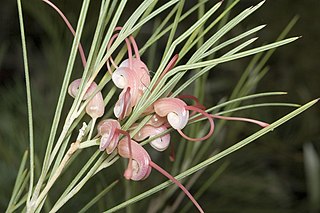
Grevillea oncogyne is a species of flowering plant in the family Proteaceae and is endemic to inland areas of Western Australia. It is an erect to spreading shrub with linear, sometimes lobed leaves, and clusters of red or pinkish red flowers.
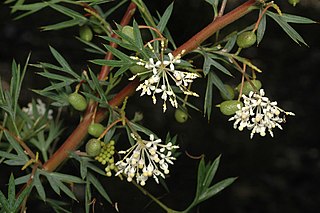
Grevillea phanerophlebia, commonly known as the prominent vein grevillea and the vein leaf grevillea, is a species of flowering plant in the family Proteaceae and is endemic to a restricted part of the south-west of Western Australia. It is an erect, spreading or straggly shrub with divided leaves, the lobes linear, and white and cream-coloured to yellow flowers.

Grevillea uncinulata, also known as hook-leaf grevillea, is species of flowering plant in the family Proteaceae and is endemic to the south-west of Western Australia. It is an erect, open shrub with linear to elliptic leaves arranged in clusters along the branches, and small clusters of white flowers, the style with a yellow, orange or red tip.
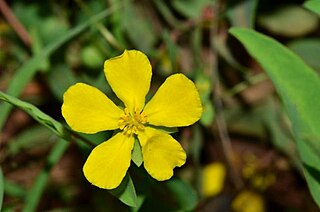
Hibbertia silvestris is a species of flowering plant in the family Dilleniaceae and is endemic to the south-west of Western Australia. It is a prostrate to more or less erect or spreading shrub with hairy young branchlets, elliptic to egg-shaped leaves with the narrower end towards the base and yellow flowers with seven to ten stamens on one side of two softly-hairy carpels.
Grevillea ceratocarpa is a species of flowering plant in the family Proteaceae and is endemic to inland areas of the south-west of Western Australia. It is an erect or spreading shrub with softly-hairy, narrowly elliptic or narrowly egg-shaped leaves with the narrower end towards the base, and creamy-white flowers.
Ricinocarpos stylosus is a species of flowering plant in the family Euphorbiaceae and is endemic to the Norseman district of Western Australia. It is a spreading, rounded, monoecious or dioeceous shrub or small tree, with linear to narrowly oblong leaves and female flowers arranged singly, or with two to five male flowers, or a single female flower surrounded by up to four male flowers.



















